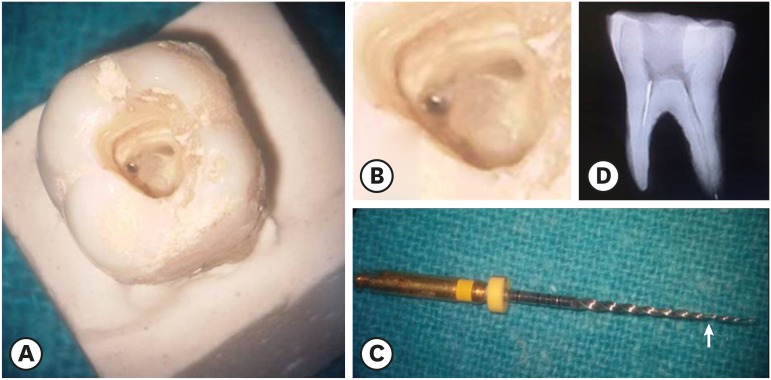1. Thompson SA. An overview of nickel-titanium alloys used in dentistry. Int Endod J. 2000; 33:297–310. PMID:
11307203.

2. Andreasen G, Wass K, Chan KC. A review of superelastic and thermodynamic nitinol wire. Quintessence Int. 1985; 16:623–626. PMID:
3865259.
3. Wolcott S, Wolcott J, Ishley D, Kennedy W, Johnson S, Minnich S, Meyers J. Separation incidence of protaper rotary instruments: a large cohort clinical evaluation. J Endod. 2006; 32:1139–1141. PMID:
17174668.

4. Iqbal MK, Kohli MR, Kim JS. A retrospective clinical study of incidence of root canal instrument separation in an endodontics graduate program: a PennEndo database study. J Endod. 2006; 32:1048–1052. PMID:
17055904.

5. Di Fiore PM, Genov KA, Komaroff E, Li Y, Lin L. Nickel-titanium rotary instrument fracture: a clinical practice assessment. Int Endod J. 2006; 39:700–708. PMID:
16916359.

6. Suter B, Lussi A, Sequeira P. Probability of removing fractured instruments from root canals. Int Endod J. 2005; 38:112–123. PMID:
15667633.

7. Ward JR. The use of an ultrasonic technique to remove a fractured rotary nickel-titanium instrument from the apical third of a curved root canal. Aust Endod J. 2003; 29:25–30. PMID:
12772969.

8. Murad M, Murray C. Impact of retained separated endodontic instruments during root canal treatment on clinical outcomes remains uncertain. J Evid Based Dent Pract. 2011; 11:87–88. PMID:
21605832.

9. Terauchi Y, O'Leary L, Suda H. Removal of separated files from root canals with a new file-removal system: case reports. J Endod. 2006; 32:789–797. PMID:
16861084.

10. Schneider SW. A comparison of canal preparations in straight and curved root canals. Oral Surg Oral Med Oral Pathol. 1971; 32:271–275. PMID:
5284110.

11. Fu M, Zhang Z, Hou B. Removal of broken files from root canals by using ultrasonic techniques combined with dental microscope: a retrospective analysis of treatment outcome. J Endod. 2011; 37:619–622. PMID:
21496659.

12. Hülsmann M. Methods for removing metal obstructions from the root canal. Endod Dent Traumatol. 1993; 9:223–237. PMID:
8143573.
13. Cattoni M. Common failures in endodontics and their corrections. Dent Clin North Am. 1963; 7:383–399.
14. Feldman G, Solomon C, Notaro P, Moskowitz E. Retrieving broken endodontic instruments. J Am Dent Assoc. 1974; 88:588–591. PMID:
4521266.

15. Roig-Greene JL. The retrieval of foreign objects from root canals: a simple aid. J Endod. 1983; 9:394–397. PMID:
6579199.

16. Eleazer PD, O'Connor RP. Innovative uses for hypodermic needles in endodontics. J Endod. 1999; 25:190–191. PMID:
10321185.

17. Johnson WB, Beatty RG. Clinical technique for the removal of root canal obstructions. J Am Dent Assoc. 1988; 117:473–476. PMID:
3183248.

18. Friedman S, Stabholz A, Tamse A. Endodontic retreatment--case selection and technique. 3. Retreatment techniques. J Endod. 1990; 16:543–549. PMID:
2084213.
19. Okiji T. Modified usage of the Masserann kit for removing intracanal broken instruments. J Endod. 2003; 29:466–467. PMID:
12877265.

20. Ruddle CJ. Nonsurgical endodontic retreatment. J Calif Dent Assoc. 2004; 32:474–484. PMID:
15344438.
21. Hülsmann M. Removal of fractured root canal instruments using the Canal Finder System. Dtsch Zahnarztl Z. 1990; 45:229–232. PMID:
2257833.
22. Plotino G, Pameijer CH, Grande NM, Somma F. Ultrasonics in endodontics: a review of the literature. J Endod. 2007; 33:81–95. PMID:
17258622.

23. Yu DG, Kimura Y, Tomita Y, Nakamura Y, Watanabe H, Matsumoto K. Study on removal effects of filling materials and broken files from root canals using pulsed Nd:YAG laser. J Clin Laser Med Surg. 2000; 18:23–28. PMID:
11189108.

24. Ebihara A, Takashina M, Anjo T, Takeda A, Suda H. Removal of root canal obstructions using pulsed Nd:YAG laser. ICS Lasers in Dentistry. 2003; 1248:257–259.

25. Ormiga F, da Cunha Ponciano Gomes JA, de Araújo MC. Dissolution of nickel-titanium endodontic files via an electrochemical process: a new concept for future retrieval of fractured files in root canals. J Endod. 2010; 36:717–720. PMID:
20307750.

26. Ruddle C. Microendodontics. Eliminating intracanal obstructions. Oral Health. 1997; 87:19–21. PMID:
9462119.
27. Ward JR, Parashos P, Messer HH. Evaluation of an ultrasonic technique to remove fractured rotary nickel-titanium endodontic instruments from root canals: an experimental study. J Endod. 2003; 29:756–763. PMID:
14651285.

28. Ward JR, Parashos P, Messer HH. Evaluation of an ultrasonic technique to remove fractured rotary nickel-titanium endodontic instruments from root canals: clinical cases. J Endod. 2003; 29:764–767. PMID:
14651286.

29. Sornkul E, Stannard JG. Strength of roots before and after endodontic treatment and restoration. J Endod. 1992; 18:440–443. PMID:
9796512.

30. Gerek M, Başer ED, Kayahan MB, Sunay H, Kaptan RF, Bayırlı G. Comparison of the force required to fracture roots vertically after ultrasonic and Masserann removal of broken instruments. Int Endod J. 2012; 45:429–434. PMID:
22188327.

31. Terauchi Y, O'Leary L, Kikuchi I, Asanagi M, Yoshioka T, Kobayashi C, Suda H. Evaluation of the efficiency of a new file removal system in comparison with two conventional systems. J Endod. 2007; 33:585–588. PMID:
17437878.








 PDF
PDF Citation
Citation Print
Print



 XML Download
XML Download